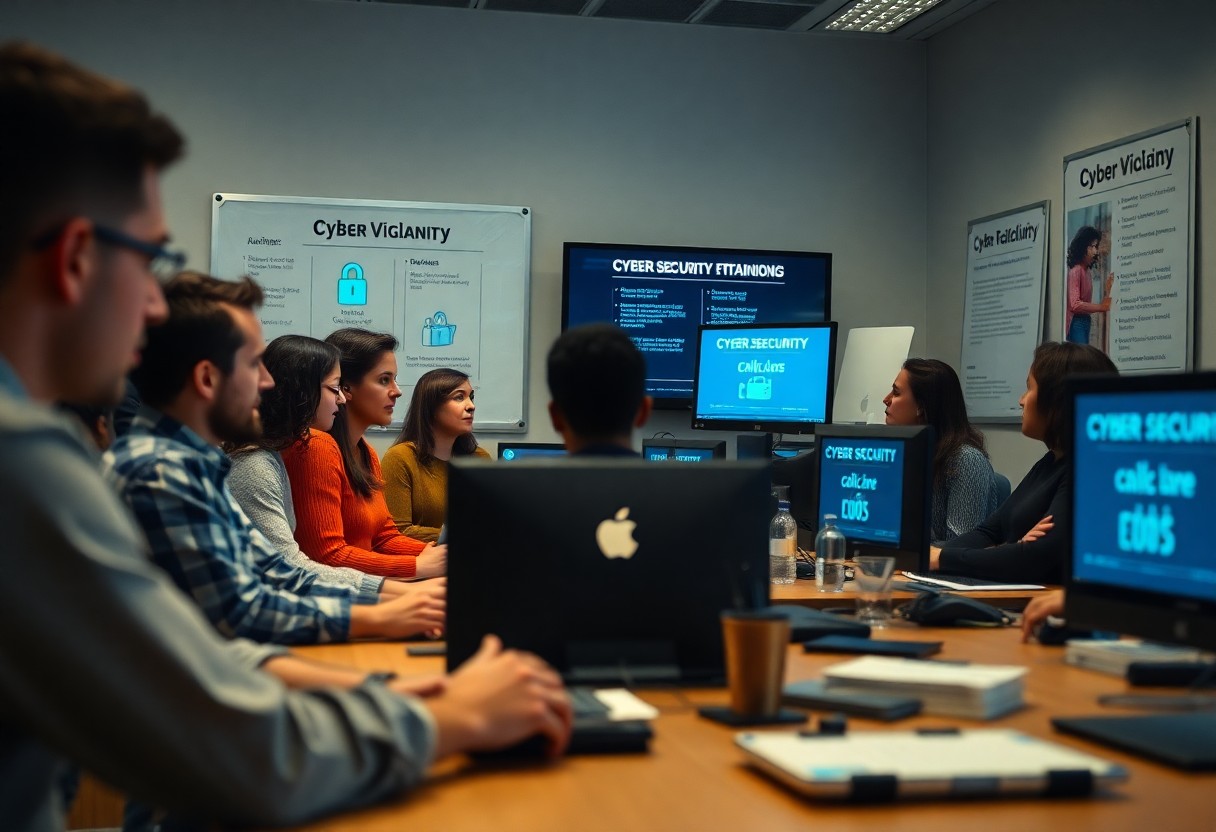Can Phishing Simulations Cultivate A Culture Of Cyber Vigilance Within Organizations?
Most organizations face the constant threat of cyber attacks, and one of the most common methods used by hackers is phishing. You might be surprised to learn that phishing simulations can play a significant role in developing a culture of cyber vigilance within your workplace. By participating in these simulations, your employees become more aware of potential risks and enhance their ability to recognize suspicious emails. This proactive approach not only helps safeguard your organization but also empowers your team to protect themselves in their personal online activities.

Key Takeaways:
- Enhanced Awareness: Phishing simulations can increase employee awareness of cyber threats, leading to a better understanding of how to recognize and respond to suspicious emails.
- Behavioral Change: Regular simulations can promote a change in behavior, making it habitual for employees to verify the authenticity of messages before acting on them.
- Organizational Culture: By integrating phishing simulations into training programs, organizations can foster a culture of cyber vigilance, encouraging proactive security measures across all levels of staff.
Understanding Phishing Simulations
Before exploring into the details, it’s important to realize that phishing simulations play a key role in enhancing your organization’s security awareness. They are designed to replicate real-world phishing attacks, giving you and your colleagues the opportunity to experience and identify potential threats in a controlled environment. This proactive approach arms you with knowledge and skills, fostering a stronger defense against cyber risks.
What are Phishing Simulations?
For organizations, phishing simulations are exercises that mimic common phishing tactics used by cybercriminals to trick employees into divulging sensitive information. By sending simulated phishing emails, these exercises allow you to test your response and identify areas for improvement in recognizing and reporting suspicious communications.
Benefits of Running Simulations
Beside providing a hands-on learning experience, phishing simulations offer numerous benefits that enhance your workplace’s cybersecurity posture. They help raise overall awareness among employees, improve reporting rates of phishing attempts, and instill a sense of accountability within your team.
Understanding the benefits of running phishing simulations can significantly contribute to your organization’s security. Not only do they help you better identify potential threats, but they also create a culture of proactive learning and engagement. By participating in these simulations, you gain valuable insights into how to spot phishing emails, overall making your workplace more resilient against cyber attacks. Additionally, these exercises enhance your organization’s ability to respond quickly and effectively, ultimately contributing to a much safer environment for everyone.
Building a Cyber Vigilant Culture
Any organization looking to foster a culture of cyber vigilance must prioritize awareness and education throughout. This means creating an environment where every employee understands their role in safeguarding sensitive information, ultimately leading to improved security practices that benefit the entire organization.
Training Employees Effectively
Behind every successful phishing simulation lies effective training. When you equip your team with the right knowledge and tools, they become far more adept at recognizing potential threats. Regular training sessions can transform your workforce into a strong line of defense against cyber threats.
Encouraging Open Communication
By fostering an atmosphere of open communication, you can empower your employees to report suspicious activity without fear of judgment. This transparency creates a proactive defense against threats and enhances overall security awareness.
Indeed, open communication acts as a vital component of your cyber vigilance strategy. When your team feels comfortable reporting concerns or asking questions, it leads to prompt action against potential threats. This open dialogue not only helps in identifying risks early but also reinforces a culture where everyone is invested in protecting your organization’s data. Encourage your employees to share their experiences and insights, thereby creating a collaborative environment that is crucial for a strong defense.
Measuring Success: Key Metrics
For organizations aiming to enhance their security posture, measuring success through key metrics is necessary. Regularly evaluating performance indicators can help identify strengths and weaknesses within your phishing simulation program, ultimately fostering a culture of cyber vigilance. Tracking metrics such as click rates and employee confidence levels will paint a clearer picture of your organization’s resilience against cyber threats.
Tracking Phishing Click Rates
Behind every phishing simulation lies the imperative task of tracking click rates. By analyzing how many employees fall for phishing attempts, you gain valuable insights into their vulnerability and the effectiveness of your training efforts. These click rates will help shape your ongoing education initiatives, ensuring that your workforce remains informed and vigilant against potential threats.
Assessing Employee Confidence
Before venturing into strategies, it’s important to focus on assessing employee confidence. Regular assessments will provide insights into how secure your team feels when encountering potential phishing emails, which indicates their understanding of security protocols.
Employee confidence is fundamental to creating a proactive cybersecurity culture. The more confident your team is in identifying threats, the better they can protect your organization. You can conduct surveys or interactive quizzes that gauge their feelings towards cybersecurity and the training provided. Building this confidence ensures that your employees are not only aware of risks but also emboldened to take appropriate actions when faced with suspicious messages.
Overcoming Common Challenges
Not every organization embraces phishing simulations with open arms. It’s common to face skepticism or reluctance from employees who may not see the value in these initiatives. Combating this resistance to change requires clear communication about the benefits and making the training engaging to encourage participation.
Resistance to Change
Between the desire for security and the need for employee engagement lies a challenge: how to motivate your team to embrace phishing simulations. Many employees may feel that these exercises are unnecessary or burdensome. To overcome this, it’s vital to foster an environment where learning is viewed positively and highlighted as imperative for both personal and organizational growth.
Balancing Learning and Security
An effective phishing simulation program must strike the right balance between educational content and maintaining a sense of security. You want your team to feel empowered and informed without instilling fear. Incorporating realistic scenarios that are also instructive can help participants learn to identify potential threats while still feeling safe in their work environment.
At the same time, it’s important to create a supportive atmosphere during simulations. By framing them as opportunities for growth and improvement, rather than punitive measures, you can alleviate anxiety. Sharing your organization’s commitment to not penalizing honest mistakes encourages open dialogue about mistakes and promotes a culture of transparency. Ultimately, this approach leads to a more aware and cyber-vigilant team, who feel confident in identifying threats, thereby enhancing overall security.
Real-Life Success Stories
All organizations can benefit from learning about real-life success stories where phishing simulations have made a difference. These case studies highlight how awareness programs have significantly improved employee responses to phishing attempts, leading to a more secure and vigilant workplace. By sharing these victories, you can inspire your team to take cyber security seriously and understand that their actions play a key role in protecting your organization.
Case Study: Company X’s Journey
Around the implementation of a tailored phishing simulation program, Company X witnessed a dramatic transformation in employee attitudes toward cyber security. Initially, the company faced a high click rate on simulated phishing emails, which prompted management to invest in education and training. Eventually, engagement rose, and employees became proactive defenders of the organization’s data.
Lessons Learned from the Field
To ensure that your organization develops a strong culture of cyber vigilance, it’s necessary to analyze successful case studies. This approach shows how consistent training enhances employee awareness and reduces susceptibility to phishing attempts. By integrating simulations into regular training, you can track progress and make necessary adjustments, keeping your workforce equipped to handle evolving cyber threats.
Further, understanding the real-world implications of phishing helps you to tailor your strategy effectively. Increased awareness can mean a significant decrease in successful phishing attempts, fostering a sense of collective responsibility among your employees. Organizations that treat these simulations not just as training but as an ongoing dialogue of defense generate positive results. By consistently prioritizing education, you empower your team to act as vigilant guardians of valuable assets, thereby laying a solid foundation for a secure environment.
Best Practices for Implementation
After planning your phishing simulation strategy, it’s necessary to implement best practices that promote success. Start by clearly communicating the purpose and benefits of the simulation to your employees, focusing on how it enhances overall security. Schedule regular simulations to maintain engagement, and keep the experience fresh by using various tactics. Encourage an open dialogue about phishing attempts and cultivate an environment where your team feels comfortable sharing their experiences and questions.
Creating Engaging Scenarios
On designing phishing scenarios, aim for authenticity and relevance to your organization’s environment. Craft emails and messages that resemble common communications your employees receive. Incorporate elements that provoke curiosity or urgency, as these are typical features of real phishing attempts. By making these simulations relatable, you’ll enhance their effectiveness and help your colleagues to recognize potential threats in a real-world context.
Ensuring Continuous Improvement
Among the key aspects of successful phishing simulations is the emphasis on continuous improvement. Following each simulation, review the results with your team to identify strengths and areas for growth. This feedback loop helps instill a proactive approach to cybersecurity awareness.
In addition, you should conduct follow-up training sessions that address any common mistakes and equip your employees with better skills for spotting phishing attempts. Consider incorporating metrics and analytics to measure progress over time, tailoring future simulations to address emerging threats or areas needing attention. This ongoing evolution not only enhances your organization’s cyber resilience but also fosters a community of vigilance, where everyone is committed to protecting valuable data.
Summing up
Presently, engaging in phishing simulations can play a significant role in fostering a culture of cyber vigilance within your organization. By actively participating in these training exercises, you empower yourself and your colleagues to recognize and respond to potential threats more effectively. Each simulation provides valuable insights that enhance your awareness and encourage open discussions about cybersecurity practices. Embracing this proactive approach will not only strengthen your defenses but also create a more informed and resilient workplace environment.
FAQ
Q: What are phishing simulations and how do they work?
A: Phishing simulations are training exercises designed to mimic real phishing attacks but in a controlled environment. Organizations use these simulations to send out fake phishing emails to employees to test their ability to recognize and respond to potential threats. If an employee clicks on a simulated phishing link, they are provided with immediate feedback on their mistake, often along with educational resources on identifying phishing attempts. This not only raises awareness but also educates employees about the indicators of phishing scams.
Q: How can phishing simulations influence employee behavior towards cybersecurity?
A: Phishing simulations can lead to a shift in employee behavior by making them more aware and proactive regarding cybersecurity. Through repeated exposure to simulated phishing threats, employees learn to be more cautious when opening emails, clicking links, or downloading attachments. Over time, this environment fosters a habit of questioning the legitimacy of communications, which contributes to an overall culture of cyber vigilance. Employees are also more likely to report suspicious activities, leading to an enhanced sense of collective responsibility towards cybersecurity within the organization.
Q: What long-term benefits can organizations expect from implementing phishing simulations?
A: Organizations can anticipate various long-term benefits from implementing phishing simulations. Firstly, they can significantly reduce the likelihood of successful phishing attacks by enhancing employee awareness and resilience. As employees become more vigilant, incidents of data breaches or ransomware attacks may diminish, leading to decreased associated costs. Additionally, fostering a culture of cybersecurity education can improve overall organizational trust among employees and stakeholders, reinforcing a commitment to protecting sensitive information. This proactive stance can also enhance the organization’s reputation, making it more appealing to clients and partners who prioritize security.
